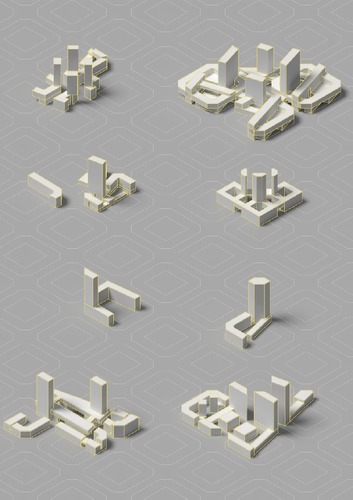Devil in the corner: rethinking corner for a new model of Cerdà/Eixample reordering

Estadístiques de LA Referencia / Recolecta
Inclou dades d'ús des de 2022
Cita com:
hdl:2117/349952
Correu electrònic de l'autoralex.chiang.07 gmail.com
gmail.com
Tipus de documentProjecte Final de Màster Oficial
Data2021-07-08
Condicions d'accésAccés obert
Llevat que s'hi indiqui el contrari, els
continguts d'aquesta obra estan subjectes a la llicència de Creative Commons
:
Reconeixement 3.0 Espanya
Abstract
The problem at the comer arised along with the construction of the first archltecture in history. Acting as force bearing point, attachment point of decoration, transition of surfaces or obstacle of sight, the interpretation of comer was limited by the mechanical properties of masonry. But when we expand our horizon from the comer of the architecture to the comer of the city, we will find the superposition of crossroad and comer, which appear simultaneously and play a critical role in shaping the spaces.Regarding the reinterpretation of comer as the breakthrough to a new conception of archltecture, architects of modernist period confronted the problem at the comer from new persepctives.
However, the comer problem of the city was remained neglected. The first urban planning in hlstory that was guided by theoretical research and focused on the intersection, crossroad and comer in the city is the Barcelona Extension Project proposed by Ildefons Cerda. The chamfered comer, along with the square created by the enclosure of the perculiar comer architecture formed as the most recognizable and outstanding character of the new city of Barcelona. In the case of urban development following strictly to the scheme made by Cerda, the problem at the comer appeared frequently in a characteristic way due to the speical parcellation pattem. Considering the specific cirumstances, architects have proposed various treatments aiming at confronting the problem at the comer and have created quiet different forms and spaces at the chamfer.
While the expansion of the city of Barcelona moving towards a metropolitan scale that will eventually cover a much wider territory, another conception of a scaled-down metropolis is proposed by Manuel de Sola-Morales who regarded 22@ district as a metaphor of a genuinely metropolitan area. Following the construction and renovation of the former industrial district, Poblenou, this area carries the potential of an envisagement of a new archltectural paradigm based on the reorientation of the conception priority on the comer.
The thesis starts with the review of the concept and development of comer through hlstory, continues with the specific focus and research on the chamfered comer of Cerda Eixample, and finally towards a discussion of an archltectural reordering of Eixample by the envisagement of a new conception of comer in a scaled-down metropolitan Barcelona.
MatèriesStreets, Eixample (Barcelona, Spain), City planning -- Eixample (Barcelona, Spain), Urban renewal -- Spain -- Barcelona, Carrers, Eixample (Barcelona, Catalunya), Urbanisme -- Eixample (Barcelona, Catalunya), Rehabilitació urbana -- Catalunya -- Barcelona
TitulacióMÀSTER UNIVERSITARI EN ESTUDIS AVANÇATS EN ARQUITECTURA-BARCELONA (Pla 2015)
Localització
GuardóDocument premiat
| Fitxers | Descripció | Mida | Format | Visualitza |
|---|---|---|---|---|
| Master Thesis_M ... dá.Eixample Reordering.pdf | 141,6Mb | Visualitza/Obre |


